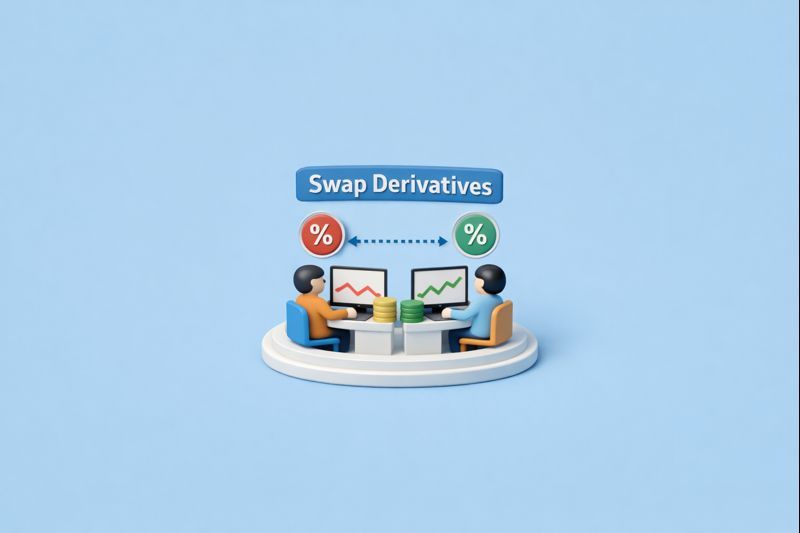- Home
- Blog
- Mutual Funds
- Target Maturity Funds
- Target Maturity Funds
Target Maturity Funds

- Published Date: September 24, 2024
- Updated Date: June 18, 2025
- By Team Choice
With the growing awareness of mutual funds and the interest rates on g-sec/GS products moving in cyclical variations with varied levels of interest, many of the risk-averse investors who relied on assured savings of capital through investment in traditional products like bank fixed deposits, PPFs, and NSCs are now shifting to debt funds. Debt funds are less volatile than equity funds and have the potential to be more tax-efficient than fixed deposits, Public Provident Funds (PPFs), and National Savings Certificates (NSCs), offering better returns.
However, investors in these instruments equally bear the risk of default (non-payment of the principal and interest) and the interest rate risk or the risk because of fluctuation in the prices of securities with changes in interest rates. Target Maturity Funds are a good substitute for such investors.
In this blog, we will discuss target maturity funds and understand how they help bring efficiency to the overall portfolio construction.
What is the Target Maturity Fund (TMF)?
Passive debt funds, TMFs track an underlying bond index. They invest only in those bonds that mature on or before the stated maturity of the fund. The bonds are held to maturity, and the interest proceeds are reinvested into the fund. Unlike Fixed Maturity Plans (FMPs), TMFs are open-ended; hence, they are more liquid and flexible. Since TMFs invest principally in government securities, Public Sector Undertaking (PSU) bonds, and State Development Loans (SDLs), their default risk is very low compared to other debt funds.
Though liquid, a TMF should preferably be held for the entire maturity period for assured returns. For TMFs, the general Total Expense Ratio (TER) is up to 50 bps on the regular side. On the other hand, actively managed debt funds enjoy a much higher TER, as high as 2%, on the regular side since managing them costs a bit more.
How Do Target Maturity Funds Work?
The target maturity date principle works based on a structured investment that is designed to combine well with an investor's financial needs. The details of the functions of TMFs are highlighted below.
Investment Strategy
TMFs invest in a portfolio of bonds maturing on a date coinciding with the stated maturity date of the fund. Thus, TMFs typically comprise government securities, PSU bonds, and SDLs. The filtering of bonds for selection would be based on their maturity coinciding with the fund's target date. This ensures that their investments are covered with its investment horizon.
Holding Period
The bonds in TMF are held till maturity. This means that the fund isn't actively trading its holdings but is maintaining all of them through the investment period. Holding the bonds to maturity can reduce interest rate risks in TMFs since their value will have lower sensitivity to fluctuation in prevailing interest rates when they can be held to maturity. During the holding period, any interest income generated by the bonds is reinvested in the fund to contribute to the overall growth.
Interest Rate Management
Over time, this fund would shift its investment to shorter-term bonds as the maturity date draws near to minimise interest rate risk. It aims to stabilise the portfolio's value as it approaches maturity, with the least fluctuation resulting from a probable interest rate shift. By the target date, a hefty percentage of the portfolio is invested in short-term, low-risk securities to guarantee the preservation of the capital to be returned to the investors.
Return of Capital
At maturity, the fund will return the shareholders' invested capital along with interests on it. As the TMFs buy bonds and hold them to maturity, the funds try to generate an estimated return that would be predictable, provided no underlying bond defaults occur. It is based on interest payments received and reinvested over the fund's life and the bonds' final redemption value.
Liquidity and flexibility
TMFs are open-ended, meaning investors can enter and leave the fund at different times. However, to reap the maximum benefit of the fund's structure and see returns come in as expected, the investment is generally considered held until maturity. This is in contrast to FMPs, which are closed-ended and require holding until the end of an investment period. The latter open nature of TMFs offers greater flexibility to investors, though early withdrawals may impact return expectations.
Risk Management
Concentration on high quality and carrying them to maturity reduces the default risk for TMFs compared with other debt funds. Emphasis on government securities and high-credit-rated bonds minimises the risk profile further. Besides, gradual shifting to short-term investments as the fund approaches maturity helps manage interest rate risk. Thus, TMFs are a relatively stable investment option for investors looking for predictable returns.
Salient Characteristics of Target Maturity Funds
Some of the critical features of TMFs make them the best alternative among risk-averse investors desiring stable returns. Here is an insight into the same:
| Feature | Overview | Benefit |
|---|---|---|
| Defined Maturity Date | TMFs are designed with a specific maturity date that aligns with the investor's financial goals. The fund liquidates its investments and returns capital along with accrued interest. | Provides a clear investment horizon, making financial planning easier around the fund's maturity date. |
| Bond Portfolio | The portfolio comprises bonds from an underlying index that matures around the fund's target date. | Ensures alignment with the fund's maturity, reducing the impact of interest rate fluctuations. |
| Accrual Mode | TMFs operate in an accrual mode, similar to FMPs, holding bonds until maturity and reinvesting interest payments received during the holding period. | Provides compounding benefits and a predictable return profile through reinvested interest. |
| Open-Ended Structure | Unlike FMPs, TMFs are open-ended, allowing investors to enter and exit the fund. However, holding until maturity is encouraged to realise expected returns. | Offers greater liquidity compared to closed-ended products, providing flexibility in managing investments. |
| Lower Default Risk | TMFs primarily invest in high-quality debt securities, including government bonds, PSUs, and SDLs. | Reduces default risk associated with other debt funds, offering a safer investment avenue. |
| Reduced Duration Risk | Investments in bonds with maturities aligned to the fund’s target date result in a decreasing duration over time. | Lessens the impact of interest rate fluctuations, making TMFs less sensitive to interest rate changes. |
| Predictable Returns | The fund’s structure aims to provide predictable returns if held until maturity, with a strategy of reinvesting interest and holding bonds to maturity. | Ideal for investors seeking stability and predictability, especially those transitioning from traditional savings products. |
Pros and Cons of Target Maturity Funds
Below are some pros and cons for you to consider:
| Pros | Cons |
|---|---|
| Predictability: Clear returns if held until maturity. | Liquidity: Limited access before maturity. |
| Diversification: A mix of government and corporate bonds reduces risk. | Interest Rate Risk: Impacted by interest rate fluctuations. |
| Tax Efficiency: Beneficial tax treatment for long-term investments. | Credit Risk: Corporate bonds may carry credit risk. |
How Do Target Maturity Funds Compare Against Other Investments?
TMFs in India can be compared with several other investment options based on various factors such as risk, returns, liquidity, and tax efficiency. Here are some similar investments to consider for comparison:
| Investment Type | Risk Level | Returns | Liquidity | Tax Efficiency |
|---|---|---|---|---|
| Target Maturity Funds | Moderate to Low | Potentially higher | Moderate | LTCG at 10% with indexation; STCG at 15% |
| Fixed Deposits (FDs) | Low | Fixed, lower | Low | Taxed as per income slab; no tax benefits |
| Debt Mutual Funds | Varies | Varies; generally higher | High | LTCG at 10% with indexation; STCG at 15% |
| Public Provident Fund (PPF) | Very Low | Lower | Low | Interest tax-free; tax deduction under Section 80C |
| National Savings Certificates (NSCs) | Very Low | Fixed, higher than FDs | Low | Tax deduction under Section 80C; interest taxable |
| Fixed Maturity Plans (FMPs) | Low | Predictable if held to maturity | Low | LTCG at 20% with indexation; STCG at 15% |
Should you Invest in Target Maturity Funds?
With interest rates expected to remain stable or decline, investors can consider Target Maturity Funds to secure higher yields. Many of these funds currently offer a yield-to-maturity (YTM) between 7.3% and 7.5%. This makes them a promising choice for those seeking steady growth in their fixed-income investments. TMFs have a higher predictability of returns as below:
A 10-year Government Security (G-Sec) yields 7.16%, while a 5-year G-Sec offers around 7.19%. Therefore, a duration of four to five years is ideal for locking in higher yields with a TMF. This timeframe aligns well with current interest rates, making it an optimal choice for investors seeking attractive returns.
Investing in TMFs requires consideration of several factors to ensure that TMFs are suitable for your goals and risk appetite. The following are the critical parameters for making an informed decision while investing in TMFs.
Investment Horizon
TMFs are designed to have a fixed maturity date, meaning the most prudent strategy for investment is to hold to maturity. Check whether the maturity date of the fund coincides with your goals. If you need liquidity before the maturity date, TMFs may not be appropriate, as early redemption may affect the returns.
Risk Appetite
Though TMFs invest only in high-quality debt securities, they are not devoid of risks. These include interest rate risk, credit risk, and liquidity risk. Assess your risk tolerance. TMFs are typically less risky than equity funds, but ask yourself whether you can stomach the possibility of interest rate changes and the credit risks accompanying them.
Return Expectations
TMFs look to generate relatively predictable returns if held to maturity. However, there remains an impact on the actual performance of the bonds constituting their portfolio and changes in the level of interest rates. Understand what the probable return profile of the fund is likely to be and whether it addresses your financial goals. Study the historical performance and quality of the bonds in the fund's portfolio.
Liquidity Needs
TMFs are open-ended, liquid funds designed to be held until maturity. If accessing your funds before maturity, the return may be affected. If you think you might need access to your money before maturity, consider whether any potential return reduction is acceptable. Consider whether the fund's liquidity features meet your investment flexibility needs.
Tax Implications
Returns from TMFs will be subject to the same set of tax laws applicable on debt funds: LTCG is taxed at 10% plus above ₹1 lakh and 15% in case of short-term gains. Consider the after-tax implications of investment in TMFs. Understanding how the imposition of such taxes will impact the overall return is important for the purpose of effective tax planning.
Fund Quality and Management
Their performance is related to the quality of the bonds that make up the fund and the fund manager's expertise. Educate yourself on the fund's management team, past performances, and the quality of bonds in the portfolio. Ensure it corresponds to your investment preference and risk profile.
Economic and Interest Rate Environment
Interest rate fluctuations may impact the performance of TMFs. When interest rates go up, bond prices may go down. However, in the case of TMFs, the impact is minimal because of their well-defined maturity profile. Keep abreast of the latest economic scenario and the prevailing interest rate cycle. Work out how these factors would impact the performance of TMFs and make an informed investment decision.
Conclusion
The investment decisions are not easy, as you must consider multiple options related to your financial goals. With their blend of predictability and growth potential, the Target Maturity Funds are an excellent addition to a well-balanced portfolio. The more you understand the nuances of TMFs, the better you will be at making informed decisions that optimise your portfolio's performance while restricting your risk. With TMFs added to your investment portfolio, you can balance stability with returns and make your investments work effectively for your financial future. Remember to revisit your portfolio periodically to improve returns and capitalise on the latest market movements.
Looking for safe and fixed-income investments? Explore the Choice platform to identify financial vehicles suitable for your personal financial goals.
Recommended for you

Swap Derivatives: Meaning, Types, Benefits And Risks

Currency Derivatives

FII DII Data - Live Data
